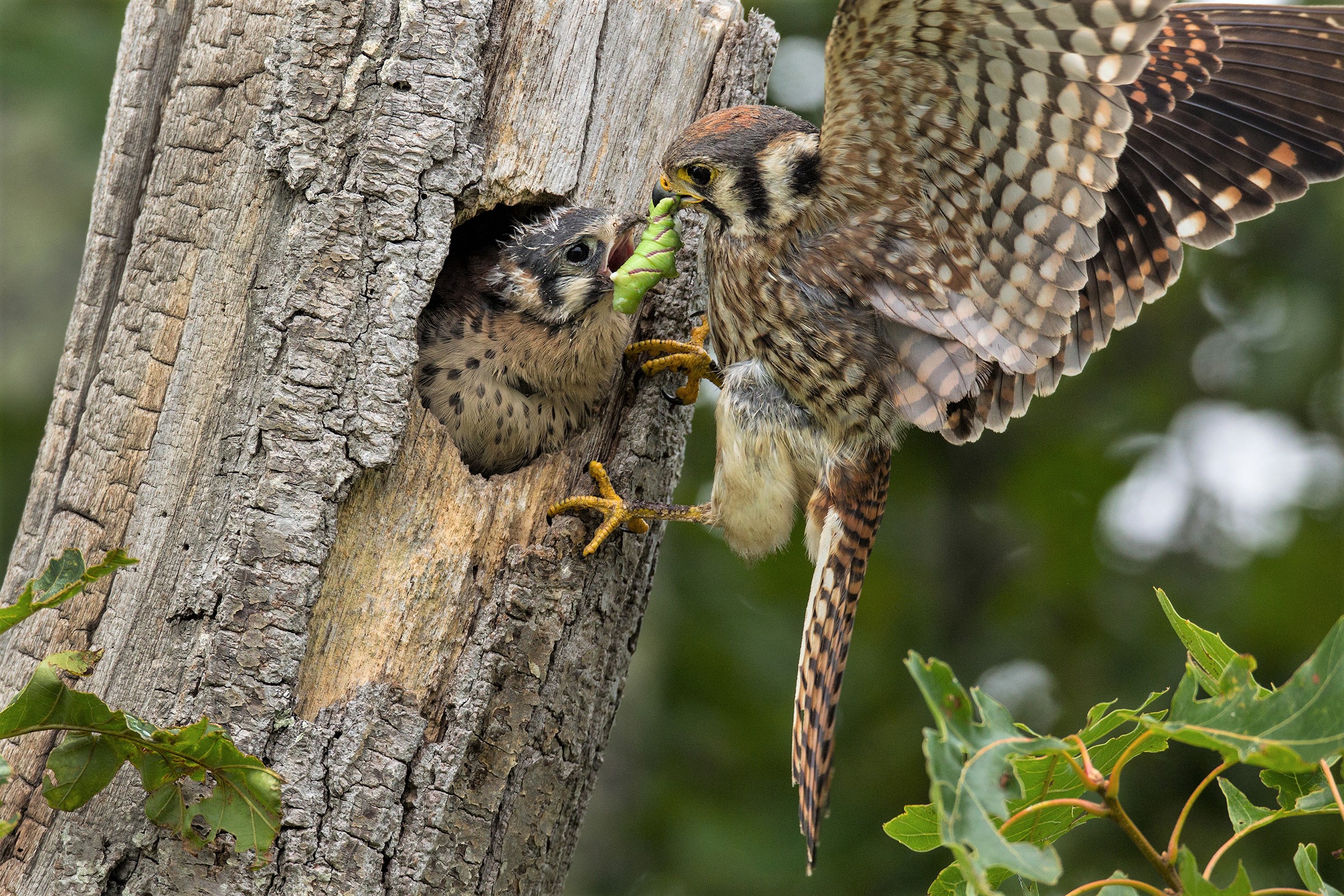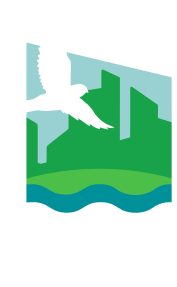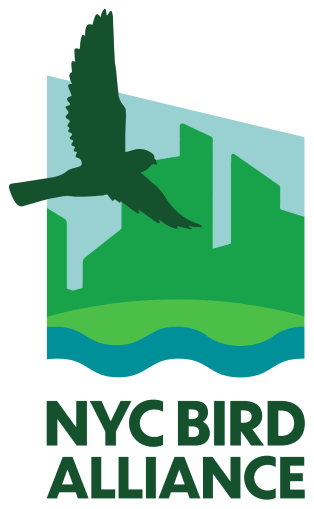Save the Bugs before It's Too Late
category: CONSERVATIONURBAN BIRD CALL

American Kestrels are among the 96 percent of land birds that feed insects (here, a protein-rich caterpillar) to their chicks. Photo: Christopher Ciccone/Audubon Photography Awards
SAVE THE BUGS BEFORE IT'S TOO LATE
This article appears in the winter 2021 issue of The Urban Audubon.
By Tod Winston
Forty years ago, when I was a preteen birdwatcher growing up in the farm country-turned-suburbs of southeastern Pennsylvania, I remember repeatedly calling out “Another kestrel!” as my father drove my friend David and me on birding adventures in my family’s station wagon. We squinted to make out the diminutive “sparrow hawks” as they flashed by, perched at regular intervals on roadside fences and telephone wires. I also remember our clouded windshield after long drives, marked with the impacts of hundreds of bugs along the way. It has been many years since I’ve had either of these experiences. On a recent birding trip to south Texas, David and I drove for several hours through what seemed like excellent kestrel country, and spotted not one kestrel. And on car trips these days, I rarely have to clean my windshield of anything but dust and soot.
These two changes are not unrelated. As you may have read in the press in recent years, ecologists warn that we are in the midst of an “insect apocalypse”: A German study published in 2017 reported that insect life in protected German green spaces had plummeted 75 percent in a period of 27 years, from 1989 to 2016. A 2019 review of relevant literature published in Biological Conservation found that 40 percent of insect species are declining globally.
North American bird life has also been declining. Ornithologists estimate that we have lost 25 percent of our birds in the past 50 years, equating to roughly 3 billion individuals. This alarming decline is surely complex in origin. Habitat loss, window collisions, and predation by feral cats are each thought to play large roles. The decline, however, has occurred predominantly among insect-eating birds; numbers of non-insect-eaters have in fact increased over the same period. Certainly, simultaneous declines in insectivorous birds and their major food source cannot be unrelated.
Insect life is fundamental to most life on earth. Pollinating insects play a critical role in all terrestrial ecosystems, and all insects lie near the base of the food chain, supporting life across the planet. Bird-lovers know of course that birds, in particular, depend on insects. The warblers and vireos we marvel over each spring, as they flock by the dozen to tall oaks during migration? They’re eating bugs. The swallows, swifts, or nighthawks that we chase with our binoculars as they swoop overhead? Also eating bugs. And perhaps most critically: the Northern Cardinals, Ruby-throated Hummingbirds, Rose-breasted Grosbeaks, Black-capped Chickadees, and American Kestrels that raise young each year in their respective habitats? No matter what they may eat at other times of the year, they are feeding bugs to their chicks. Among land birds, 96 percent feed insects to their chicks, in order to supply them with the protein they need to develop properly, according to research by entomologist Douglas Tallamy. A 2018 study published by Narango, Tallamy, and Marra showed a direct link between insect prey availability and breeding songbird populations.
What is behind the catastrophic loss of insect life that is being observed across the planet? Habitat destruction and a reduction in the proportion of native plant species (upon which native insects depend) are both thought to be important factors. And one need not look far for another primary cause: Scientists estimate that in 2020 alone, 3.5 million tons of pesticides were distributed across the Earth. This broad group of substances comprises various classes of chemicals including insecticides, herbicides, rodenticides, and fungicides. All these pesticide types may have direct or indirect negative effects on insects, birds, and other wildlife. More and more studies, however, point to pervasive and increased use of insecticides as—unsurprisingly—a fundamental cause of insect decline. A 2019 study estimated that over the past 25 years, the American agricultural landscape has become 48 times more toxic to honeybees. This increase was found to be primarily due to an increase in one class of insecticides, called neonicotinoids, estimated to produce 92 percent of the increased toxicity found. A recent study has also shown a specific link between neonicotinoid use and bird population decline. (Learn more about neonicotinoid insecticides below.)
Concerned citizens must awaken to the danger posed by ubiquitous insecticide use before it is too late. Many of us felt grief and disgust in reading the report of confirmed extinctions published this fall by the U.S. Fish & Wildlife Service, which included 23 kinds of wildlife including 11 bird species. The Ivory-billed Woodpecker, Bachman’s Warbler, and nine unique Hawaiian bird species are gone for good. “How could people have let such things happen?” we ask ourselves. I have often asked myself that question when mourning another bird long confirmed extinct, the Passenger Pigeon. This North American species, thought to have possibly been the most numerous bird in the world in the early 1800s, once traveled in flocks so immense they were reported to block out the sun.
Surely, today, we know better. But according to the 2019 research review mentioned above, the total mass of insects across the Earth is “falling by a precipitous 2.5 percent a year, according to the best data available, suggesting they could vanish within a century.” The prospect of something as ubiquitous and commonplace as insects “vanishing” is so shocking as to seem absurd. But is it? One need only look to the Passenger Pigeon for an answer.
THE GROWING EVIDENCE AGAINST “NEONICS”
Over the past 30 years, neonicotinoid insecticides have rapidly become the most common insecticide class used across the Earth. Meaning literally “new nicotine-like insecticides,” neonicotinoids such as imidacloprid, clothianidin, and thiamethoxam exert an effect on nerve synapses similar to that of nicotine. Relative to earlier classes of insecticides, these substances were thought to be improvements: They were found to be extremely toxic to invertebrates while exerting fewer apparent toxic effects on humans and other higher organisms. They are also water-soluble, making them a “systemic” insecticide: when applied to the ground or directly to crop seeds, they are absorbed with water by germinating plants via their root systems.
In practice, however, research has shown that the extreme toxicity, water-solubility, and persistence in the environment of neonicotinoids make them far too good at their job. Their systemic nature makes all parts of treated plants—leaves, fruit, and pollen—insecticidal. And the chemicals’ potency is such that just one treated corn kernel contains enough active ingredient to kill over 80,000 honeybees. Only an estimated 2 to 3 percent of the chemical applied to each seed is absorbed into the germinating plant, however; the rest disseminates into the soil, and as it is water-soluble, contaminates both soil and water supply, concentrating after year-after-year use.
A growing body of evidence, including several worldwide research assessments by Cornell University and studies funded by the pesticide industry, links increased neonicotinoid use to massive losses in bee populations. In New York State, beekeepers have lost more than 40 percent of their honeybee colonies for the last decade, and wild native bees are thought to be similarly affected.
Studies have specifically linked neonicotinoid use to declining bird populations: a 2020 study in the U.S. found that “an increase in neonicotinoid use led to statistically significant reductions in bird biodiversity between 2008 and 2014 … particularly for grassland and insectivorous birds, with average annual rates of reduction of 4% and 3%, respectively.” Research has shown additional negative impacts on deer, fish, and other wildlife. According to the Center for Disease Control, 50 percent of the U.S. population is exposed to these same chemicals.
Bans on common neonicotinoids are already in place in Europe (though work needs to be done to close loopholes in those laws), and a number of initiatives are being pursued in the U.S. In New York State, the Birds and Bees Protection Act has been introduced by Assemblyman Steve Englebright and Senator Brad Hoylman. (Englebright and Hoylman were also sponsors of 2019’s Bird-Friendly Building Council Act, which was ultimately vetoed by Governor Cuomo). The Birds and Bees Protection Act would eliminate between 80 and 90 percent of neonicotinoid use in the state, forbidding coated seeds and non-agricultural uses. The bill draws on Cornell University research, which weighed environmental vs. economic costs and found that the neonic uses most toxic to pollinators provided little-to-no agricultural benefit and were replaceable with less toxic alternatives.
The Birds and Bees Protection Act has been passed by the New York State Senate, and will be considered for passage by the State Assembly in early 2022. To learn more and find out how to support this important legislation, see our Avian Advocates page.
Information in this article was drawn from research publications listed below, as well from this Neonicotinoid Fact Sheet produced by Audubon New York and other partners.
In practice, however, research has shown that the extreme toxicity, water-solubility, and persistence in the environment of neonicotinoids make them far too good at their job. Their systemic nature makes all parts of treated plants—leaves, fruit, and pollen—insecticidal. And the chemicals’ potency is such that just one treated corn kernel contains enough active ingredient to kill over 80,000 honeybees. Only an estimated 2 to 3 percent of the chemical applied to each seed is absorbed into the germinating plant, however; the rest disseminates into the soil, and as it is water-soluble, contaminates both soil and water supply, concentrating after year-after-year use.
A growing body of evidence, including several worldwide research assessments by Cornell University and studies funded by the pesticide industry, links increased neonicotinoid use to massive losses in bee populations. In New York State, beekeepers have lost more than 40 percent of their honeybee colonies for the last decade, and wild native bees are thought to be similarly affected.
Studies have specifically linked neonicotinoid use to declining bird populations: a 2020 study in the U.S. found that “an increase in neonicotinoid use led to statistically significant reductions in bird biodiversity between 2008 and 2014 … particularly for grassland and insectivorous birds, with average annual rates of reduction of 4% and 3%, respectively.” Research has shown additional negative impacts on deer, fish, and other wildlife. According to the Center for Disease Control, 50 percent of the U.S. population is exposed to these same chemicals.
Bans on common neonicotinoids are already in place in Europe (though work needs to be done to close loopholes in those laws), and a number of initiatives are being pursued in the U.S. In New York State, the Birds and Bees Protection Act has been introduced by Assemblyman Steve Englebright and Senator Brad Hoylman. (Englebright and Hoylman were also sponsors of 2019’s Bird-Friendly Building Council Act, which was ultimately vetoed by Governor Cuomo). The Birds and Bees Protection Act would eliminate between 80 and 90 percent of neonicotinoid use in the state, forbidding coated seeds and non-agricultural uses. The bill draws on Cornell University research, which weighed environmental vs. economic costs and found that the neonic uses most toxic to pollinators provided little-to-no agricultural benefit and were replaceable with less toxic alternatives.
The Birds and Bees Protection Act has been passed by the New York State Senate, and will be considered for passage by the State Assembly in early 2022. To learn more and find out how to support this important legislation, see our Avian Advocates page.
Information in this article was drawn from research publications listed below, as well from this Neonicotinoid Fact Sheet produced by Audubon New York and other partners.
SOURCES
Hallmann, Caspar A., Martin Sorg, Eelke Jongejans, Henk Siepel, Nick Hofland, Heinz Schwan, Werner Stenmans et al. "More than 75 percent decline over 27 years in total flying insect biomass in protected areas." PloS One 12, no. 10 (2017): e0185809.
Sharma, Anket, Vinod Kumar, Babar Shahzad, Mohsin Tanveer, Gagan Preet Singh Sidhu, Neha Handa, Sukhmeen Kaur Kohli et al. "Worldwide pesticide usage and its impacts on ecosystem." SN Applied Sciences 1, no. 11 (2019): 1-16.
Narango, Desirée L., Douglas W. Tallamy, and Peter P. Marra. "Nonnative plants reduce population growth of an insectivorous bird." Proceedings of the National Academy of Sciences 115, no. 45 (2018): 11549-11554.
Rosenberg, Kenneth V., Adriaan M. Dokter, Peter J. Blancher, John R. Sauer, Adam C. Smith, Paul A. Smith, Jessica C. Stanton et al. "Decline of the North American avifauna." Science 366, no. 6461 (2019): 120-124.
Li, Yijia, Ruiqing Miao, and Madhu Khanna. "Neonicotinoids and decline in bird biodiversity in the United States." Nature Sustainability 3, no. 12 (2020): 1027-1035.
Grout, Travis A., Phoebe A. Koenig, Julie K. Kapuvari, and Scott H. McArt. "Neonicotinoid Insecticides in New York State." (2020).
Sharma, Anket, Vinod Kumar, Babar Shahzad, Mohsin Tanveer, Gagan Preet Singh Sidhu, Neha Handa, Sukhmeen Kaur Kohli et al. "Worldwide pesticide usage and its impacts on ecosystem." SN Applied Sciences 1, no. 11 (2019): 1-16.
Narango, Desirée L., Douglas W. Tallamy, and Peter P. Marra. "Nonnative plants reduce population growth of an insectivorous bird." Proceedings of the National Academy of Sciences 115, no. 45 (2018): 11549-11554.
Rosenberg, Kenneth V., Adriaan M. Dokter, Peter J. Blancher, John R. Sauer, Adam C. Smith, Paul A. Smith, Jessica C. Stanton et al. "Decline of the North American avifauna." Science 366, no. 6461 (2019): 120-124.
Li, Yijia, Ruiqing Miao, and Madhu Khanna. "Neonicotinoids and decline in bird biodiversity in the United States." Nature Sustainability 3, no. 12 (2020): 1027-1035.
Grout, Travis A., Phoebe A. Koenig, Julie K. Kapuvari, and Scott H. McArt. "Neonicotinoid Insecticides in New York State." (2020).




